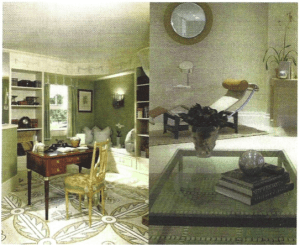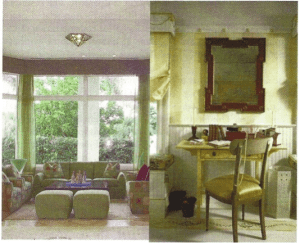The Country House—Not A Mouse, But A Home
“Eye on Design” Archive from Mann Report (Article By Gail Green)

We commonly think of the Country House as a respite from city life, a refuge from the hustle and bustle of urban sights and sounds. The 18th and 19th century writers have set the landscape, flush with flora and fauna. Shingle style, log cabin, whitewashed brick are typically envisaged types of homes we think of as the country house. Perhaps little mice run abound the creaking stairs, a hunting dog running to and fro and small children kicking their feet in a nearby pool. The country house arouses these warm homey effects in our imagination — a Wonderland away from Wall Street.
Whether the house is in the woody climes of Connecticut, the sandy beaches of the Hamptons or Nantucket, the hills of the Catskills, or the gentrified grasses of Palm Beach, the country home typifies a certain laid-back, comfy environment which the city sites do not approach. Unlike our urban homes, the inside of the weekend home reflects the landscape in mood and color. For instance, in Palm Beach a house that is nestled amidst bright green, red, pink and purple flora takes on those colors within. All the fabrics are cotton, the tables are glass and metal, the floors are a cool limestone with metal inserts and the tabletops are concrete.
For the sandy Hamptons climes, landscapes are more neutral toned to reflect the blue sky and beige beaches. The feeling here is light, bright and airy. Woods are light toned, more so than in the city — limed oak is a perfect match. Fabrics tend to be sheer and white, gracefully billowing in the summer breezes. Flashes of color brighten the throw pillows and patterns in the area rugs.
Sandblasted glass light fixtures insure the airiness of the summer feeling. Leather is another great material to use in these instances; it is easy to maintain and always a cool comfortable surface upon which to sit. Wicker furniture– easy to maintain and very summery — takes the lead, especially on the exterior of the house.
The shingle style home, well known to the Hamptons and Cape Cod, gives a casual yet stately feeling to the country house. Rather than the modern interiors of a concrete shell, the insides of these homes are more traditional. Blue, greens, beiges are predominant colors. Medium colored woods texture the furniture– warmer, richer tones prevail. Wiltons surface the floors, fabrics cover the walls, kitchen cabinets are latched, knobs are round or oval and the rooms are more distinct from one another. The bathrooms have traditional plumbing fittings with inserted tile patterns, reflecting the loss of a former era.
Finally, the wooded climes house homes that are very natural to the environment. Rust, browns, beiges, yellows and deep reds prevail. These colors reflect the enclosing trees, yellow daffodils, berries, and bushes outside. Deep colored Navajo patterns are favored. Dark woods are most common. Many accessories abound. Warm and cozy is the effect here. Woodbacked chairs and, oftentimes, plaid fabric seats accompany heavy wood dining and coffee cables. Pictures with antique frames adorn the tables.
The Country House takes on many shapes inside and out, but what it does distinctly is differ from the city abode. In its numerous differing features, the House reassures its urbane denizens a level of serenity nor found elsewhere.


*Note – Article adapted from print. Images reflect reduced quality.
Click here to view original print article.
____
Like this post?
Subscribe to our newsletter for more design tips, tricks and insights!

